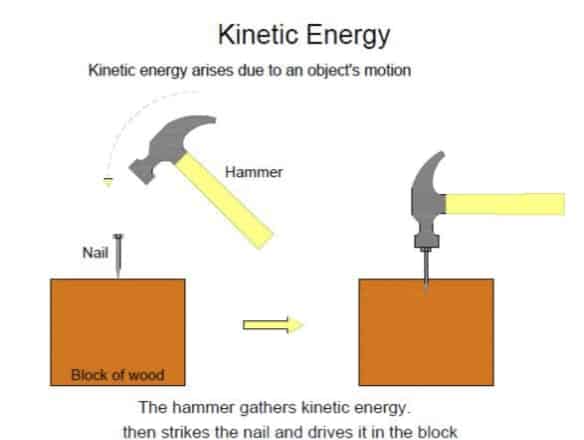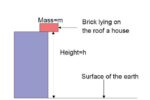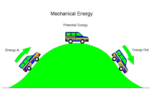Kinetic energy, types, and examples.
The kinetic energy in simple is the energy of motion. It can be observed as the movement of a body. Oxford Language Dictionary says kinetic energy in physics is “energy which a body possesses by virtue of being in motion.”
Kinetic energy:
The kinetic energy in simple is the energy of motion. It can be observed as the movement of a body. Oxford Language Dictionary says kinetic energy in physics is “energy which a body possesses by virtue of being in motion.”Each and every moving body or particle has kinetic energy.
Kinetic energy may be defined as the work needed to accelerate an object of any given mass from rest to motion. Kinetic energy is the property of the object or body in motion, depends on its mass and velocity.
It is believed that the word “kinetic” derives its name from the Greek word “kinetikos” meaning “of motion”.
The formula for calculating kinetic energy as such;
KE=1/2mv2,
where KE is kinetic energy. m=mass of the object in kilograms, v= velocity of the object in meters/second. All the above calculations are in the SI unit and energy is in Joules.
Kinetic energy can be transformed into other forms of energy during its motions and may be categorized as translational,( a train in a rail line/an athlete running on a track), rotational( the earth travels in its orbit), and vibrational (pendulum).
Types of kinetic energy:
Kinetic energy includes radiant energy, thermal energy, sound energy, and electrical energy.
Radiant energy:
Radiant energy is a form of kinetic energy, generated by electromagnetic radiation, which remains always in motion, and travels through space or medium. It travels in waves. Examples;
- X-Ray.
- Radio waves.
- Ultraviolet rays.
Thermal energy:
Thermal energy is often referred to as heat energy. It is produced due to a rise in temperature causing the atoms and molecules of a substance to move faster and collides with each other. Heat is a flow of thermal energy. The amount of thermal energy depends on its temperature, number of atoms/molecules, and physical status. Examples:
- Solar energy.
- Geothermal energy.
- Heating a bowl of water.
Sound energy:
A sound is a form of kinetic energy produced by the vibration of objects. When an object vibrates, it causes the movement of the air molecules in the surroundings as it travels through the medium in waves. Examples;
- Beating drum.
- Siren in police vehicle/ambulance.
- Sonar.
Electrical energy:
Electrical energy is generated by the movement of charged particles, known as electrons from one point to another. Further, we may say the movement of charged particles through a medium, produces electric energy. It is a constant flow of electrons. Examples;
- Lightning.
- Solar cells.
- Electric eels.
Examples of kinetic energy:

- Walking: When a person starts walking the chemical energy of the person is converted into kinetic energy till he stops.
- Swimming: Swimming is another example of kinetic energy. When a swimmer starts swimming, the chemical energy of his/her body is converted into kinetic energy. The amount of kinetic energy produced depends on the speed and the mass of the athlete.
- Cycling: During cycling, the chemical energy of the body is converted into kinetic energy, and during pedaling some heat energy is also produced.
- Throwing a baseball: When a baseball is thrown to a certain distance large amount of kinetic energy is produced due to the fast velocity of the ball.
- Windmills: Windmill is another bright example of kinetic energy. When the wind makes the blades of the mill spin, creates kinetic energy.
- Moving vehicle: When a vehicle is in motion, that creates kinetic energy, where chemical energy is converted into kinetic energy. The vehicle with heavy mass and velocity has more kinetic energy than the vehicle with less mass and the same velocity.
- Moving aircraft: When the aircraft increases its speed, the chemical energy of the plane is converted into kinetic energy.
- A golf ball: A golf ball when at rest on a tee has no kinetic energy and after a strike, kinetic energy is generated.
- A flying bird: A flying bird generates kinetic energy according to its weight and speed.
- A fountain: A fountain has a large amount of kinetic energy when falling from high altitude to low, where the potential energy is transferred to kinetic energy.
- A butterfly: We all know the beauty of a butterfly. When it flies it generates a small amount of kinetic energy.
- Hammer: The hammer gathers kinetic energy and strikes the nail to drive the nail into the wood, cupboard, or wall according to the situation’s demand.

Transformation of kinetic energy:
The total energy in a system is always constant, which is the established law of conservation of energy. The law further says energy can’t be created or destroyed but may be converted from one form to another. It is also true in the case of kinetic energy. Let us take some examples for the understanding of the same.
Moving Car;
When a car starts moving, the chemical energy of the car is converted into kinetic energy. If the vehicle rides a hilly road, its kinetic energy is converted to potential energy at the highest tip of the road, and when it comes down the road potential energy is converted into kinetic energy. During driving some heat energy is also produced. Further during the journey, if the driver applies brakes some kinetic energy is converted to heat energy through friction.

A Roller coaster;
A roller coaster is a type of familiar amusement ride that witness the conversion of kinetic energy to potential energy and from potential energy to kinetic energy many times during the course of the ride.
The sum of kinetic energy and potential energy in a system is called mechanical energy.
Conclusion:
Kinetic energy is the energy of motion. Kinetic energy includes radiant energy, thermal energy, sound energy, and electrical energy, We encounter kinetic energy at every step in our daily life. Walking, running, cycling, driving, and swimming like everyday activities where we are involved in Kinetic energy. It may be converted into other forms of energy including potential energy, heat energy, etc.




9 Comments
Great article for students. Explained in a lucid way🙏🏽
Thankyou
[…] Potential energy is the stored energy of the system as it has the potential to perform a certain task when released. It can be divided into the following types, such as gravitational, elastic, nuclear, chemical, electric potential energy, etc. Further, it may be transformed into other forms of energy like kinetic energy. […]
Nice one sir 🙏🏽👍
Excellent 👌👌👌. Every Concept of energy explained in a very simple way that’s easy to understand.
Thankyou 👍
Well explained Sir
Thankyou 👍
[…] energy includes both kinetic and potential energy. At one point of time, either potential energy or kinetic energy remains in […]